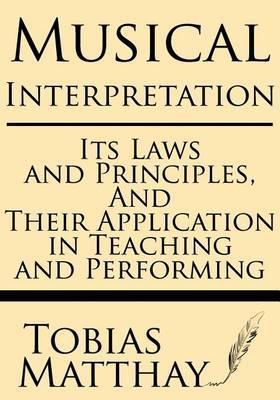Musical Interpretation: Its Laws and Principles, and Their Application in Teaching and Performing

Musical Interpretation: Its Laws and Principles, and Their Application in Teaching and Performing
Musical Interpretation: Its Laws and Principles, and their Application in Teaching and Performing
By Tobias Matthay
Contents I-Some General Principles of Teaching and Learning II-The Nature of Musical Attention and of Musical Shape III-The Element of Rubato IV-Concerning Certain Details in the Application of Tone-inflection and the Bearing of Touch-teaching and Fingering, etc., on Interpretation V-As to Pedalling and the Element of Duration VI-The Purpose of Art-expression and its Relation to the Infinite
Preface FOR many years past I have been urged to put into a permanent and available from my enunciation of those Principles and Laws of Interpretation, knowledge of which has proved to be one of the main causes of the success of the army of teachers who have arisen from my school. The first step towards this end was the preparation, in the year 1909, of a set of Lectures covering this ground. These I condensed later into a single lecture, and this was first delivered publicly in Manchester to Dr. Carroll's Association of Teachers during the season of 1909-10. Subsequently, it was repeated to the Edinburgh Musical Education Society, to the London Music Teachers' Association (in 1910) and its Branches; it was also given at the Royal Academy of Music in the same year, and at my own School, and elsewhere. It will be found, that while this work deals with the subject mainly from the pianist's point of view, nevertheless most of the principles here formulated apply with equal force to all other forms of musical performance. Many of the same laws of Interpretation which apply to Pianoforte playing also hold good whether we are players of stringed instruments or wind instruments, or are vocalists, organ-players or conductors. We cannot play even on a penny whistle without coming under the sway of such laws! Hence I hope that this little volume may prove helpful to all music-teachers and would-be performers, artists as well as students, whatever their specialty. Some of the main points here dealt with are: [ the difference between letting a pupil shift for himself and helping him to learn; the difference between mere cramming and real teaching; the difference between merely making a pupil "do things" and teaching him to think - to the end that he may know what to do, why to do it, and how to do it; the exposition of the true nature of Rhythm and Shape in Music - as Progression or Movement towards definite landmarks; the true nature of Rubato in a
PRP: 108.42 Lei
Acesta este Prețul Recomandat de Producător. Prețul de vânzare al produsului este afișat mai jos.
97.58Lei
97.58Lei
108.42 LeiLivrare in 2-4 saptamani
Descrierea produsului
Musical Interpretation: Its Laws and Principles, and their Application in Teaching and Performing
By Tobias Matthay
Contents I-Some General Principles of Teaching and Learning II-The Nature of Musical Attention and of Musical Shape III-The Element of Rubato IV-Concerning Certain Details in the Application of Tone-inflection and the Bearing of Touch-teaching and Fingering, etc., on Interpretation V-As to Pedalling and the Element of Duration VI-The Purpose of Art-expression and its Relation to the Infinite
Preface FOR many years past I have been urged to put into a permanent and available from my enunciation of those Principles and Laws of Interpretation, knowledge of which has proved to be one of the main causes of the success of the army of teachers who have arisen from my school. The first step towards this end was the preparation, in the year 1909, of a set of Lectures covering this ground. These I condensed later into a single lecture, and this was first delivered publicly in Manchester to Dr. Carroll's Association of Teachers during the season of 1909-10. Subsequently, it was repeated to the Edinburgh Musical Education Society, to the London Music Teachers' Association (in 1910) and its Branches; it was also given at the Royal Academy of Music in the same year, and at my own School, and elsewhere. It will be found, that while this work deals with the subject mainly from the pianist's point of view, nevertheless most of the principles here formulated apply with equal force to all other forms of musical performance. Many of the same laws of Interpretation which apply to Pianoforte playing also hold good whether we are players of stringed instruments or wind instruments, or are vocalists, organ-players or conductors. We cannot play even on a penny whistle without coming under the sway of such laws! Hence I hope that this little volume may prove helpful to all music-teachers and would-be performers, artists as well as students, whatever their specialty. Some of the main points here dealt with are: [ the difference between letting a pupil shift for himself and helping him to learn; the difference between mere cramming and real teaching; the difference between merely making a pupil "do things" and teaching him to think - to the end that he may know what to do, why to do it, and how to do it; the exposition of the true nature of Rhythm and Shape in Music - as Progression or Movement towards definite landmarks; the true nature of Rubato in a
Detaliile produsului









